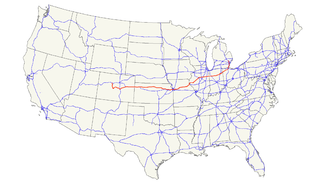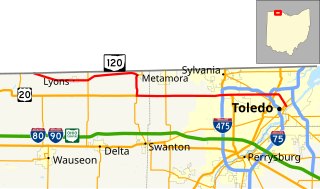Craig Memorial Bridge | |
|---|---|
 The Craig Memorial Bridge in 2008 with the Veterans' Glass City Skyway in the background | |
| Coordinates | 41°40′N83°31′W / 41.66°N 83.51°W Coordinates: 41°40′N83°31′W / 41.66°N 83.51°W |
| Carries | |
| Crosses | Maumee River |
| Locale | Toledo, Ohio |
| Characteristics | |
| Design | Bascule bridge |
| History | |
| Construction end | 1956 |
| Opened | 1957 |
The Robert Craig Memorial Bridge is a four-lane, double-leaf bascule bridge that spans the Maumee River approximately one mile downstream from downtown Toledo, Ohio. The bridge is named in memory of U.S. Army Second Lieutenant Robert Craig, a Scottish-born Toledoan who posthumously received the Medal of Honor during the Second World War.

A bascule bridge is a moveable bridge with a counterweight that continuously balances a span, or "leaf", throughout its upward swing to provide clearance for boat traffic. It may be single- or double-leafed.

The Maumee River is a river running from northeastern Indiana into northwestern Ohio and Lake Erie in the United States. It is formed at the confluence of the St. Joseph and St. Marys rivers, where Fort Wayne, Indiana, has developed, and meanders northeastwardly for 137 miles (220 km) through an agricultural region of glacial moraines before flowing into the Maumee Bay of Lake Erie. The city of Toledo is located at the mouth of the Maumee. The Maumee was designated an Ohio State Scenic River on July 18, 1974. The Maumee watershed is Ohio’s breadbasket; it is two-thirds farmland, mostly corn and soybeans. It is the largest watershed of any of the rivers feeding the Great Lakes, and supplies five percent of Lake Erie’s water.

Toledo is a city in and the county seat of Lucas County, Ohio, United States. Toledo is in northwest Ohio, at the western end of Lake Erie bordering the state of Michigan. The city was founded in 1833 on the west bank of the Maumee River, and originally incorporated as part of Monroe County, Michigan Territory. It was re-founded in 1837, after conclusion of the Toledo War, when it was incorporated in Ohio.
Opening to traffic during January 1957, the Craig Memorial Bridge was notable as one of the few movable bridges on the Interstate Highway System as it carried Interstate 280 over the Maumee River shipping channel; it remained as such until the June 2007 completion of the Veterans' Glass City Skyway project. Since the re-routing of I-280, the bridge is now a local route—connecting Summit Street (on the west side of the river) to Front Street (on the east side). As such, the Craig Bridge has assumed the local role of its predecessor—an unnamed bridge that connected Ash Street to Consaul Street until its demolition following the opening of the Craig Bridge. Upon completion of the Glass City Skyway, State Route 65 was extended across the Craig Bridge from North Summit Street to Front Street. [1] [2] [3] [4] [5]

The Dwight D. Eisenhower National System of Interstate and Defense Highways, commonly known as the Interstate Highway System, is a network of controlled-access highways that forms part of the National Highway System in the United States. Construction of the system was authorized by the Federal Aid Highway Act of 1956. The system extends throughout the contiguous United States and has routes in Hawaii, Alaska, and Puerto Rico.
Interstate 280 (I-280) is a 12.41-mile-long highway that connects I-75 in northeast Toledo, Ohio with I-80/I-90 southeast of the city in northeastern Wood County, Ohio. Built between 1955 and 1959, the route was originally part of the Detroit-Toledo Expressway. Although first designated in 1959, the highway originally contained several at-grade intersections and other features which left it substandard to the Interstate Highway System until 1990. Further construction in 2007 built a new crossing of the Maumee River, replacing an outdated drawbridge. The highway serves as an easterly bypass of metropolitan Toledo, passing through the communities of Northwood and Oregon. It is one of two auxiliary Interstate highways serving Toledo, the other being Interstate 475.

The Veterans' Glass City Skyway, commonly called the Toledo Skyway Bridge, is a cable-stayed bridge on Interstate 280 in Toledo, Ohio. After many delays, it opened in 2007. The bridge has taken traffic and reduced delays on the Robert Craig Memorial Bridge, a bascule bridge that was, until its transfer to local control, one of the last moveable bridges on the Interstate highway system. The Skyway is Ohio Department of Transportation's (ODOT) biggest single construction project.











